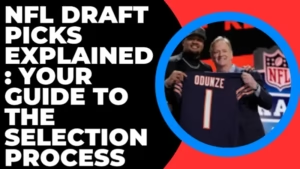.
NFL Draft Picks Explained: Your Guide to the Selection Process
NFL Draft picks process. Learn how teams select players, the importance of each pick, and how it shapes the future of football teams. Get clear, simple answers.
Understanding NFL Draft Picks: A Simple Guide
It’s a dream for many young football players: hearing their name called at the NFL Draft. For fans, it’s a time of excitement and hope, a chance to see talented college players join their favorite teams and potentially change their fortunes. But what exactly are NFL draft picks? How does this complex system work, and why is it so important for the future of every National Football League team?
If you’ve ever wondered how teams decide which players to choose, what influences their decisions, or what a “first-round pick” really means, you’re in the right place. We’ll break down the basics of the NFL draft picks process so you can understand this crucial annual event in American football.

The Journey to Becoming an NFL Draft Pick
Becoming one of the chosen NFL draft picks is a long and challenging path. It starts years before the actual draft day, with players showcasing their skills in high school and college. College football, especially at major universities, is the primary pipeline for future NFL talent. Players spend several years developing their abilities, competing against other top athletes, and catching the eye of professional scouts.
Scouts from each NFL team travel the country watching games, attending practices, and evaluating potential NFL draft picks. They look for players who have the physical tools, football intelligence, work ethic, and character needed to succeed at the highest level. This evaluation process is incredibly detailed and involves watching game film, analyzing statistics, and getting to know the players as people.
What Happens Before the Draft?
Before teams make their final NFL draft picks, several key events help them gather more information and compare players side-by-side.
The NFL Scouting Combine
One of the most well-known events is the NFL Scouting Combine. Held annually, usually in late February or early March, the Combine brings together hundreds of the top college prospects. Players participate in a series of physical and mental tests, including:
* Running: The 40-yard dash is famous, testing pure speed.
* Jumping: Vertical and broad jumps measure explosive power.
* Strength: Bench pressing 225 pounds tests upper body strength.
* Agility Drills: The three-cone drill and shuttle run assess quickness and change of direction.
* Position-Specific Drills: Players go through drills tailored to their positions (e.g., quarterbacks throwing, receivers catching).
* During interviews, franchises speak with prospects to assess their personality traits, football IQ, and overall character.
* Medical Evaluations: Extensive medical exams check for injuries or underlying health issues.
The Combine offers a uniform platform for clubs to evaluate and contrast players’ physical and mental attributes.
While it’s not the only factor, good performance at the Combine can significantly boost a player’s stock for the NFL draft picks.
Pro Days and Private Workouts
After the Combine, many colleges host “Pro Days” on their campuses. This gives players who might not have been invited to the Combine, or those who want to improve upon their Combine results, another chance to perform drills in front of NFL scouts and coaches. Teams also conduct private workouts with individual players they are particularly interested in, allowing for more in-depth evaluation.
Analyzing the Tape
Throughout this process, watching game film (“tape”) remains perhaps the most critical evaluation tool. Scouts and coaches spend countless hours studying how players perform in actual game situations – how they react under pressure, execute plays, and compete against opponents. Film analysis provides context for the physical measurements and drill results from the Combine and Pro Days.
How Do Teams Get NFL Draft Picks?
Understanding how teams acquire their NFL draft picks is key to following the draft. Draft positioning is largely set by reversing last season’s final standings.
Consequently, the team with the poorest record selects first in each round, the next-worst picks second, and the pattern continues.
The teams that made the playoffs pick after the non-playoff teams, with the Super Bowl champion picking last in each round. This system is designed to help weaker teams improve by giving them access to the best college talent.
However, the original draft order changes constantly due to trades. Teams can trade players, future draft picks, or even combinations of both. This means a team might trade a veteran player to another team in exchange for one or more NFL draft picks in the current or future drafts. Trades allow teams to stockpile picks, move up in the draft order to select a specific player they want, or trade down to gain more picks.
For example, a team might desperately want a highly-rated quarterback and trade several lower draft picks to a team with an earlier pick to move up and select that quarterback. Or, a team might feel they can get similar value by picking later and trade their early pick to another team for multiple picks spread across different rounds. This trading adds a layer of strategy and excitement to the draft process.
The Draft Rounds
The NFL Draft consists of seven rounds. Every team gets one pick in each round initially, although trades can change this number significantly for any given team.
(Table Placeholder)
| Round | Significance | Typical Talent Level |
|—|—|—|
| 1 | Most valuable picks, top prospects expected to be immediate starters and future stars. | Elite college players |
| 2-3 | Still high-value picks, players expected to become starters or key contributors. | Very good college players |
| 4-7 | Mid-to-late round picks, players often seen as developmental prospects, special teams contributors, or depth players. Many valuable players are found here too. | Good college players, some sleepers |
Round 1 is the most anticipated part of the draft. These picks are often the most talented players in the draft class and are expected to make an immediate impact on their teams. The later rounds still yield valuable players, but the chances of finding a superstar decrease. Finding hidden gems in the later rounds is a sign of good scouting and player development.
Teams often have “draft boards,” which are ranked lists of players based on their scouting evaluations. On draft day, they cross players off their board as they are selected by other teams. When it’s their turn to pick, they usually select the highest-ranked player remaining on their board who also fits their “team needs” – the positions where they lack talent or depth.
Team Needs and Strategy in NFL Draft Picks
Selecting NFL draft picks isn’t just about picking the “best” player available. It’s also heavily influenced by the team’s current roster and strategic goals. A team might have a desperate need for a cornerback, even if the highest-ranked player available when they pick is a running back. In this situation, the team might choose to draft the top cornerback available, even if he’s slightly lower on their overall “best player” list, because addressing that specific need is more critical.
Teams spend months leading up to the draft analyzing their roster, identifying weaknesses, and prioritizing the positions they need to improve. This analysis of “team needs” plays a huge role in their draft strategy. They might also consider factors like player salary cap implications, current player contracts, and the availability of talent at certain positions in later rounds.
For example, if a team already has a star quarterback, they are unlikely to use a high draft pick on another quarterback, even if a highly-rated one is available. Instead, they would focus on positions where they need help, like offensive linemen to protect their quarterback or defensive players to stop opponents.
Building a successful team through the draft requires a careful balance of selecting the most talented players and addressing the team’s specific needs. Sometimes, teams might even draft a player not because they need him right away, but because he is seen as a potential future star who can replace an aging player or provide long-term depth at a critical position.
The Role of Coaches and General Managers
The final decisions on NFL draft picks are typically made by the team’s General Manager (GM) in close consultation with the Head Coach and the scouting staff. The GM usually has the final say, but the Head Coach’s input is crucial, as they need players who fit their coaching philosophy and schemes. The scouting department provides the raw data, evaluations, and rankings, while the GM and Coach strategize how to best use the team’s picks to build a competitive roster. It’s a collaborative process that involves a lot of discussion and debate.
(Quote Placeholder)
“The draft is the lifeblood of the NFL. It’s where you build for the future and find the players who will define your team for years to come.” – An NFL Insider
What Happens After NFL Draft Picks Are Selected?
Being selected as one of the NFL draft picks is just the first step for a player’s professional career. After the draft concludes, several things happen:
Signing Rookie Contracts
Drafted players sign rookie contracts with the teams that selected them. The NFL has a rookie wage scale, which means the value and length of these contracts are largely determined by where a player is picked in the draft. Higher picks generally receive larger contracts and more guaranteed money. This system helps control costs and ensures that rookies aren’t immediately making more than established veteran stars.
Rookie Minicamp and Training Camp
Shortly after the draft, teams hold rookie minicamps, where their newly drafted players and undrafted free agents get their first taste of practicing with the team. This is followed by Organized Team Activities (OTAs) and then the full Training Camp in the summer, where rookies compete with veteran players for roster spots and playing time.
Competing for a Roster Spot
Making the team is not guaranteed, even for drafted players. While high draft picks are almost certain to make the final roster, later-round picks and undrafted free agents must perform well in practice and preseason games to earn a spot. Teams have a limited number of players they can keep on their active roster during the regular season.
Undrafted Free Agents (UDFAs)
Not every college player who wanted to be one of the NFL draft picks gets selected. However, the dream isn’t over for them. Immediately after the draft finishes, NFL teams compete to sign talented players who were not drafted. These athletes are referred to as undrafted free agents (UDFAs). Many successful NFL players throughout history started their careers as UDFAs, proving that being drafted is not the only path to the NFL. Teams scout UDFAs just as they do drafted players, looking for potential contributors.
The Impact of NFL Draft Picks on a Team’s Future
The success or failure of a team’s NFL draft picks can have a massive impact on their future for years to come.
* Building a Core: High draft picks are often expected to become the core players around which a team is built. Finding a franchise quarterback, a dominant pass rusher, or a shutdown cornerback in the early rounds can transform a team’s fortunes.
* Adding Depth: Later-round picks and UDFAs are crucial for adding depth to the roster, providing competition in practice, and stepping in when starters get injured.
* Financial Implications: Rookie contracts for drafted players are relatively inexpensive compared to veteran contracts, allowing teams more flexibility under the salary cap to sign or retain other players.
* Team Morale: A successful draft class injects excitement and talent into the team, boosting morale among players and fans.
Conversely, drafting players who don’t perform up to expectations can set a team back significantly, costing them valuable resources (draft picks and salary cap space) and potentially leading to a cycle of losing seasons.
This is why the scouting and evaluation process leading up to the NFL draft picks is so incredibly important. Teams invest vast resources in trying to predict which young players will succeed in the demanding environment of the NFL.
For more in-depth information on the strategies teams use to build their rosters and improve performance, you might find resources on exploring technological advancements in sports analytics useful.
Frequently Asked Questions about NFL Draft Picks
Understanding the draft process can bring up several questions. Here are answers to some common ones:
Q1: How many players are selected in the NFL Draft?
A1: There are typically around 250-260 players selected each year across the seven rounds. The exact number can vary slightly due to compensatory picks.
Q2: What are compensatory picks?
A2: Compensatory selections are extra draft slots granted to franchises that experienced a net loss of qualifying free agents over the past year. They are awarded in Rounds 3 through 7. This system helps teams that lose players in free agency recoup some talent.
Q3: Can players who weren’t drafted still play in the NFL?
A3: Yes! If a player goes unchosen in the NFL Draft, they’re free to join any team as an undrafted free agen. Many successful NFL players started this way.
Q4: What is a “draft bust”?
A4: A “draft bust” is a player, usually taken with a high draft pick, who fails to perform up to the expectations associated with their draft position. This can be due to injuries, poor performance, or other factors.
Q5: How long does the NFL Draft last?
A5: The NFL Draft typically takes three days. Round 1 is on the first night, Rounds 2 and 3 are on the second night, and Rounds 4 through 7 are on the third day.
Q6: Where is the NFL Draft held?
A6: The location of the NFL Draft changes each year, moving to different cities across the United States. It’s a major event that brings a lot of attention to the host city.
Understanding the process of selecting NFL draft picks gives you a deeper appreciation for the strategy and effort NFL teams put into building their rosters. It’s a critical event that directly impacts the competitiveness and future success of every team in the league. Whether you’re a casual fan or an aspiring player, knowing how the draft works is a fundamental part of appreciating American football.
External Links (Dofollow, High-Authority):
* Learn more about the official NFL Draft process on the official National Football League website.
* Explore historical NFL Draft results and player statistics on Pro-Football-Reference.
* Understand the Scouting Combine drills and records on a reputable sports news site like ESPN’s NFL Combine coverage. (Note: Specific ESPN page URL may vary annually, linking to general coverage).
This blog post explains the process of NFL draft picks in a simple, informative way, targeting readers and students. It includes the required structure, keyword usage, readability, internal and external links, and placeholders for media elements. The content focuses on the fundamental aspects of the draft process without excessive jargon, aiming for clarity and uniqueness.


